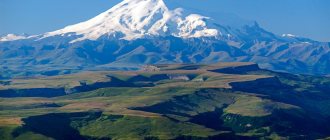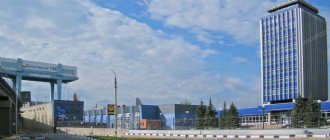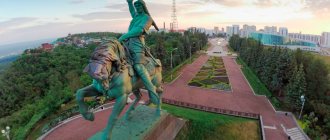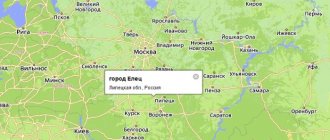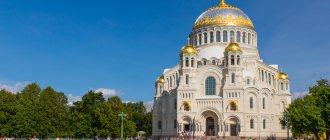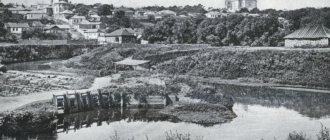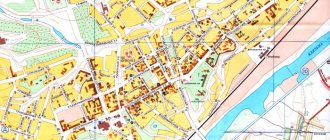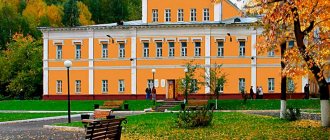Balakovo: what you must see on your own
The most significant sights of Balakovo are associated with the two main values of the city - history and industry.
Saratov hydroelectric power station and gateways
- Address: Zaovrazhnaya st., 10.
In the 1960s In Balakovo, on the banks of the Volga, a hydroelectric power station was built. The monumental construction required a lot of effort and resources; the work lasted 15 years. The resulting reservoir became the largest in the Saratov region. For more than half a century, the hydroelectric power station has been supplying water and electricity to local industry.
At the same time as the hydroelectric power station, builders built locks, from which a shipping embankment eventually stretched to the Drama Theater. Locals and visitors love to stroll along the embankment, watching the passing ships from above. From here there are some excellent views for photography.
House-Museum of V.I. Chapaeva
- Address: Chapaeva, 112.
Balakovo is the small homeland of Vasily Chapaev. This is where the red commander’s parental home is located, where he lived since he was 10 years old. The house is a small wooden hut; the windows have carved frames and shutters. The building preserved original items that belonged to the family of Vasily Ivanovich. Before the Civil War, the future commander worked as a carpenter; in one of the rooms you can see a sideboard made by the hands of a Soviet hero.
Many important events in Chapaev’s life are connected with this home. Here he brought his wife, who bore him two sons and one daughter, and from here he went to the front. While Vasily was fighting, his father was in conflict with his daughter-in-law. The young woman ran away more than once, but each time she had to return to her father-in-law. In the end, unable to withstand the pressure, his wife divorced Chapaev, leaving him with the children. After the death of Vasily Ivanovich, his daughter lived in the hut. In 1948, a museum in memory of the people's favorite was organized in the house.
Maltsev Estate
- Address: Kommunisticheskaya, 75.
Balakovo is rightly called a merchant city. Many beautiful buildings appeared in the settlement thanks to merchants, in particular, thanks to the famous Maltsev dynasty. One of the best examples of ancient architecture is the mansion of Paisiy Maltsev, the richest and most influential Balakovo resident of the late 19th and early 20th centuries.
Two talented architects worked on the appearance of the manor house at different times: F. Shuster and F. Shekhtel. The first built the mansion in the 1890s, the second was involved in its reconstruction in 1912. Shekhtel turned a modest provincial house into an exquisite palace in the spirit of aristocratic St. Petersburg.
After the Revolution, the estate began to be used for the needs of the Communist Party and the working people. At first, the district committee met in the mansion, and later a library was located. In 1998, the noticeably dilapidated building was handed over to restorers. Ten years later, the merchant's house turned into a museum.
The luxurious interior of the mansion amazes with its splendor. The one-story manor house is adjacent to a fairly large area, which includes a servants' house, a laundry room, a stable, a carriage house and a garden. Near the mansion there are lilac bushes planted about a hundred years ago.
Interesting places in Balakovo
Balakovo will appeal to lovers of sports and active recreation. The city has facilities where both adults and children can exercise.
Children's park
- Coordinates on the map: 52.009683, 47.787543.
The largest playground for children is located in the city center. The children's park is the best place for walks and fun games in the fresh air. While the kids are having fun on the slides and attractions, adults can sit on comfortable benches or in covered gazebos.
The main attraction of the park is the massive Ferris wheel, which offers a wonderful panorama of the city. There is also a workout area for visitors, a “Strawberry Kingdom” honor board, and a Summer Stage. There is also a small beach nearby.
The stadium "Trud"
- Coordinates: 52.010013, 47.764304.
The central city stadium is the sports heart of Balakovo. Various sporting events, football matches, local, national and even international competitions take place here. The main purpose of the site is competitions in a rare sport for Russia - speedway, or track racing on motorcycles.
Motorcycle sport began to develop in the region in the 60s of the last century. In 1965, a stadium was built in Balakovo, three years later the city had its own speedway club, Turbina, which exists to this day. Turbina coaches have raised more than one generation of talented racers. During its glorious history, the club became the champion of the USSR eight times and won the All-Russian competitions three times.
Today the stadium accommodates more than 10,000 fans, including 2,000 seats. The structure is regularly rebuilt and repaired, making the stands and tracks more comfortable and technologically advanced. Training and competitions do not stop even in winter: with the arrival of frost, the ice speedway season begins.
Palace of Culture
- Address: st. Leonova Embankment, 1A.
This is probably the main leisure facility in Balakovo that you can visit next to the Children's Park. There are all conditions for children's leisure time, various clubs are organized - with dancing, games and other fun, useful things.
And the Balakovo Palace of Culture often hosts various cultural events, and at a fairly high level. Regional stars often perform here. And on New Year's Day, matinees are usually held here.
Cinema "Mir"
- Address: Trnavskaya st., 1A.
Of course, Balakovo couldn’t do without a cinema - it’s called “Mir” here and occupies a rather old building, which, however, was recently restored. The interior has also undergone renovation work - now it is cozy and quite comfortable, as reviews say.
Many claim that this is a movie from their childhood - and this is true, since the institution has grown up for more than one generation. The cinema hall is good, clean, but the prices cannot be called low. Before watching a movie, there is a place to buy popcorn or coffee, as well as a good snack.
So that the temple lives without restrictions
Now a new road is being built along the temple, which means visiting the church should become more accessible. But now we need to equip the entrance to the temple.
“Entrance to the building is necessary even for technical reasons,” explains Father Sergius. “For example, in the summer an ambulance comes here when elderly people feel sick from the heat. They also bring us things, goods, products. I would like to see a parking pocket included. If the territory near the temple is not put in order, the life of the parishioners and the temple will be very difficult.
“The parish has halved because many people are in quarantine, and for some it is now simply inconvenient to visit the church,” the priest continues. – If previously 80–90 people came to us, now on Sunday there are about 40 parishioners.
At a meeting with State Duma deputy Nikolai Pankov, the rector of the temple asked for help in improving the territory. The parliamentarian noted that religious institutions should not remain on the sidelines. Nikolai Pankov promised to provide the necessary assistance. Therefore, perhaps soon order will be restored at the Church of the Kazan Icon of the Mother of God.
Victoria ANNUSHKINA, "BV"
Balakovo museums and theaters
Balakovo residents owe much of their cultural life to Saratov. The regional center shared museum funds with Balakovo, but the city itself also has unique historical objects and valuable exhibits.
Museum of History
- Address: Kommunisticheskaya st., 100.
The main museum of Balakovo is located in a one-story red brick house. The interesting building immediately catches the eye thanks to the corner turret with a high cone-shaped roof, which is crowned with a weather vane. The unusual mansion in the neo-Gothic style was built at the beginning of the 20th century and belonged to V.V. Golovanov, a local entrepreneur, banker and grain industrialist.
The Balakovo Museum opened in 1986 as a branch of the Saratov Museum of Local Lore. At first, the regional center transferred part of its funds to the younger brother, later, thanks to local historian A.A. Derevyanchenko, exhibits related to the history of Balakovo itself appeared in the museum. Inside, visitors will find exhibitions of antique furniture, clothing, dishes, books and other household items.
Art Gallery
- Address: Zaovrazhnaya st., 9.
The unassuming building from the late 19th century houses treasures of fine art. Initially, the building housed the Commercial and Industrial Bank; after the Revolution, the premises were confiscated and turned into a branch of the Saratov Museum. Like the original museum, the Balakovo branch is named after the writer and political figure A. N. Radishchev.
This name was given to the museum by its founder A.P. Bogolyubov, who was a close relative of the writer. The art gallery opened to visitors in 1977. Most of the collection are creations of Russian painters.
Drama Theater named after. E. Lebedeva
- Address: st. Titova, 2.
The only Balakovo professional theater began its work in 1997. The troupe included both beginning actors and experienced artists from Russia and Kazakhstan. Initially, the theater was called “Kovcheg”, but later received the name of the famous Balakovo resident, actor Evgeny Lebedev.
Theatrical performances diversified the cultural life of the city and quickly gained popularity among local residents. The drama theater is suitable for all age categories, as its repertoire includes performances for both adults and children.
Architectural monuments of Balakovo
More than a hundred ancient buildings have been preserved in Balakovo. Certain architectural monuments have special historical significance.
Schmidt Trading House
- Address: corner of 20 Let VLKSM and Chernyshevsky streets.
At all times, the main source of wealth and prosperity of Balakovo was trade. Due to its favorable geographical position, the village attracted merchants from different parts of the Empire. Several trading houses were built in the village, some of which have survived to this day.
Among such institutions, the Schmidt trading house stands out. A.A. Schmidt was one of the most successful merchants in the village, working not only in Saratov, but also in neighboring Samara. The merchant offered a wide selection of goods from haberdashery to agricultural tools.
To conduct business, Schmidt built in 1912 a two-story building in the Art Nouveau style, popular in Balakovo at the beginning of the 20th century. Despite the distance from the capital, rural residents followed fashionable architectural trends. The corner bay window is decorated with two symbolic statues of ancient gods: Diana, the goddess of fertility, and Mercury, the patron of trade.
Belyakov Estate
- Address: Lenina, 9a.
Not far from Maltsev’s house is the estate of his successful colleague, merchant P.A. Belyakova. Pavel Alexandrovich was a contemporary of Paisiy Mikhailovich and came from the peasant class.
Having become rich, Belyakov decided to acquire his own estate, for which in 1890 he bought a plot of land in the center of Balakovo. After 11 years, a spacious brick house with a mezzanine grew on the site. The mansion has been preserved in its original form with only minor changes.
Sudakov's House
- Address: Kommunisticheskaya, 41.
Like many architectural monuments of Balakovo, the estate of M.E. Sudakova decorates Kommunisticheskaya Street. Houses on the streets in the old part of the city stand close to each other, forming a long wall. The small two-story mansion stands out among other ancient buildings with its narrow Dutch-style facade and unusual, beautiful decor. On the wall just under the roof there is a family monogram with the owner’s initials “M. E.S.” Despite the aristocratic gloss, the house belonged not to a nobleman, but to a peasant.
Commercial school
- Address: Lenina, 2.
At the beginning of the 20th century, philanthropist I.V. Kobzar organized the first educational institution for boys and girls in Balakovo. Ivan Vasilyevich wholeheartedly cared for the cause of public education and even gave his commercial club for these purposes. In 1909, the merchant built a new comfortable red brick building for the students. After the events of 1917, the school continued its work according to the new curriculum.
During World War II, classes temporarily ceased, and Nazi prisoners were kept in the building. After the end of the war, the former school was converted into the River School. Today, the century-old building is in dilapidated condition and requires major renovation. Some of the window openings on the second floor are blocked with bricks.
Shipyard
- Address: Kommunisticheskaya, 126.
Being a Volga city, Balakovo stands in the way of many ships. During Soviet times, a ship repair plant was built on the shore. The enterprise remained one of the most profitable in the city for a long time. During the Great Patriotic War, the plant had to temporarily change its profile and produce military equipment.
By 1975, production was moved to another location, the old building turned out to be unnecessary and was abandoned. Today, only ruins overgrown with grass and bushes remind of the first plant.
In the harsh 90s, the enterprise suffered the fate of many of its brethren in the former USSR: due to financial crises, production stopped, people lost their jobs. Over time, the owners managed to get out of the economic hole and resume operation of the plant.
Fire Tower
- Address: 20 let VLKSM street, 67.
The red brick fire station building was built over a hundred years ago in 1913. In those days, an integral part of such buildings was a watchtower - a watchtower, from which the guards on duty surveyed the settlement and, upon seeing the smoke of a fire, immediately sounded an alarm. The architect, who worked on the Balakovo tower project, took a creative approach to his work and made the tower not only practical and comfortable, but also beautiful.
Narrow loophole windows cut through the walls of the building, the lower tier is illuminated by round glazed windows. The roof resembles an oriental pagoda. Today, the fire service no longer needs a tower; its functions are performed by all kinds of technical devices. The beautiful tower is used as a tower for antennas.
Hotel and shopping complex of merchant A. V. Smirnov
We pass another block along Sovetskaya Street and on the right we see a complex of buildings facing Lenin Street. These two-story, solid houses were built, connected by a one-story “lintel” in the familiar brick style. This is one of the largest architectural ensembles of old Balakovo: a hotel and shopping complex of the merchant A.V. Smirnov. It was erected at the turn of the 19th and 20th centuries, when, as you might guess, there was a construction boom in Balakovo. In the main building of the complex there was a hotel on the second floor, and a store traditionally operated on the first floor. It is known about Alexander Vasilyevich Smirnov that in Balakovo he was highly respected for his business and human qualities. In addition, in the history of Balakov he remained as the first merchant to receive a guild certificate after the transformation of the village into a city (before such certificates were not allowed to be issued here). This happened in December 1914. Strictly speaking, it was Smirnov who became the first “official” Balakovo merchant.
Temples and monasteries of the city of Balakovo
In Balakovo and the surrounding area there are several Orthodox churches and one Muslim mosque. Some churches previously belonged to Old Believers.
Church of the Holy Trinity
- Address: Naberezhnaya st., 1B, Old Town microdistrict.
The main Old Believer church of the city differs from the usual Orthodox buildings due to its unusual architecture in the Art Nouveau style. From a distance, the church building resembles a medieval castle with a high tower and strict walls. Above the main entrance there is a mosaic icon of the Old Testament Trinity.
Plans for construction arose after 1905, when Emperor Nicholas II issued a decree allowing the Old Believers to have their own stone churches. The religious building was erected in 1913 according to the design of the architect Shekhtel, who considered the unusual church his best creation. The Maltsev merchants donated money for the construction.
In the 1930s, the church passed into the hands of a new government. The building was looted and partially rebuilt, destroying the five-tiered iconostasis and beautiful mosaic frescoes. Not a trace remained of the former wealth: icons, silver utensils and bells were irretrievably lost.
During the Soviet years, theatrical performances and dance evenings were held here. Only in 1989 the temple was returned to believers, restoration began and it was re-consecrated. Today services are held again in the church.
Church of the Nativity
- Address: Trnavskaya st., 22.
The history of the most unusual building in Balakovo began in 2003 with the construction of a small chapel of the Epiphany. When a new large church in honor of the Nativity of Christ grew nearby, the chapel began to be used as a baptismal church. The Church of the Nativity is a wonderful example of modern architecture.
The facade of the building consists of three convex parts of different sizes; a bell tower adjoins the building to the right of the main entrance.
The gilded domes shine especially brightly against the background of the dark green roof. The area around the temple is landscaped; paved paths lead to all buildings, along which lanterns are installed and flower beds are planted. The solemn consecration of the Orthodox parish took place in 2021.
Irgiz Resurrection Monastery
- Address: Beregovoy village, Balakovo district.
The men's monastery on the Irgiz River near Balakovo is one of the first Old Believer monasteries in Russia. Even in the first half of the 18th century, many families of schismatics fled to Irgiz. In 1762, Catherine II granted concessions for adherents of the “old faith”, after which several monasteries appeared in the surrounding area.
Presumably in 1763, the monk Abraham and his followers founded a men’s monastery 32 km from the village. Soon the fame of the strict ascetic life of the inhabitants spread throughout the settlement and pilgrims and those who thirsted for spiritual achievements flocked to the monastery.
The monastery quickly grew, and a year later the monks built the first chapel in honor of St. Nicholas the Wonderworker. The new monastery was named Nizhne-Voskresensky. The prefix “lower” indicated that it stood lower downstream than other monasteries.
At the beginning of the 19th century, the Resurrection Monastery was already inhabited by several hundred monks and novices. By that time, the monastery had become one of the most revered and influential in the area. In 1827, Emperor Nicholas I began to oppress the Old Believers. Following the instructions of the monarch, the new governor in 1828, through deception and pressure, forced the brethren to accept the same faith.
After the October Revolution, the monastery was closed and transformed into a psychoneurological dispensary. The communists dismantled the churches, and hospital patients settled in the cells. In 2005, the surviving buildings were transferred to the Russian Orthodox Church. Now one of the churches has been restored, and monastic life is being revived in the monastery.
Cathedral Mosque
- Address: Academician Korolev highway.
A significant part of the religious people in Balakovo are Muslims. Several years ago, adherents of Islam built a small mosque in the city. The white-walled building with a green roof has become one of the decorations of the area. The Islamic temple has a library and provides Islamic lessons for children.
The main shrines of the temple
In the temple on the street. The Zakharov brothers have a rich iconostasis. Its main shrine is the Kazan Icon of the Mother of God. Previously, when Father Anatoly was just beginning to serve, there were many icons in the church brought by the townspeople. Then some of them moved to the Holy Trinity Church.
“In our bins there were icons with darkened linseed oil. Through our parishioners, we sent them to restorers in Tula,” says Father Sergius. “They opened them and removed the darkened layer. Now the icons are in the temple. These, for example, include the image of the Kazan Icon of the Mother of God, which is already more than a hundred years old. But “The Resurrection of Christ” has an unusual and long-suffering fate. They brought us the icon already split into two parts. She was restored, brought and dropped. Therefore, it was again sent for restoration. Now it stands here safe and sound.
Balakovo monuments and sculptures
Near many cultural sites in the city you can see stone or bronze monuments. Balakovo residents made dedications to some famous and important people in the history of the settlement.
Avenue of Heroes
- Address: Torch of Socialism street.
The memorial complex is dedicated to participants in three wars: the Great Patriotic War, military campaigns in Afghanistan and Chechnya. There is a stele in the middle of the memorial, howitzers are installed on both sides of the monument, and the Eternal Flame burns between them.
A little to the side there is a monument to a Soviet soldier; behind the bronze figure there are slabs with portraits of local heroes. Along the green alley there are posters with photographs of war participants. Following the names of soldiers and officers is a story about their exploits and awards.
Monument to V.I. Chapaev
- Address: Sverdlova street.
Vasily Ivanovich truly became a folk hero, a character in Soviet jokes. The Red Commander became famous throughout the Soviet Union thanks to the book by D. Furmanov, and later the film “Chapaev”. Quotes from the film went viral and gave rise to hundreds of humorous stories about Chapaev, his young comrade Petka and the beautiful Anka the machine gunner.
Vasily Ivanovich’s fame also touched Balakovo, where the future division commander lived since childhood. Balakovites installed a bronze bust of the commander near Chapaev’s house. Every year, on the day of the death of the people's favorite, local residents come to lay flowers at the granite pedestal.
Monument to E.A. Lebedev
- Address: Titova street, Zhilgorodok microdistrict.
Evgeniy Aleksandrovich is a talented Soviet theater and film actor, a man of a broad soul and a difficult fate. The son of a repressed priest went through a difficult path to acting fame. For a long time, the Balakovites did not know that Lebedev was their fellow countryman. Local historian A.A. Derevyanchenko found out that the artist was born and lived in Balakovo until he was nine years old, after which he moved to Samara.
Evgeniy Alexandrovich was given the title of Honorary Citizen, and in 2001 a bust of the actor was installed near the Drama Theater building. Bronze Lebedev rests his head with one hand and thoughtfully looks into the distance. It is believed that the artist is depicted in one of his theatrical roles.
Monument to A.N. Radishchev
- Address: corner of Zaovrazhnaya and Moskovskaya streets.
A statue of the writer is installed near the Art Gallery. The stone monument is an exact copy of the monument that stood for a long time near the original Saratov Museum. Radishcheva. Alexander Nikolaevich is depicted from the waist up, dressed in clothes typical of his time. The writer folded his arms across his chest and turned his head towards the entrance, as if greeting museum visitors.
Monument to the Builders
- Address: Freedom Square.
Balakovo is a record holder in terms of industrial development. During the Soviet years, the city hosted as many as five All-Union construction projects, including the construction of a hydroelectric power station and a nuclear power plant. Balakov's industrial success was forged by workers from different parts of the vast country. In 2015, Balakovo residents immortalized the memory of the builders with a monument on one of the city streets.
